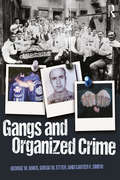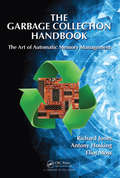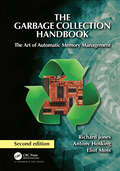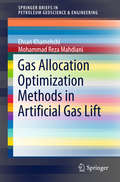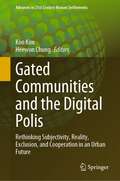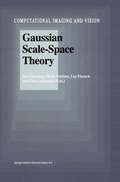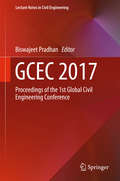- Table View
- List View
Gangs and Organized Crime
by George W. Knox Gregg Etter Carter F. SmithIn Gangs and Organized Crime, George W. Knox, Gregg W. Etter, and Carter F. Smith offer an informed and carefully investigated examination of gangs and organized crime groups, covering street gangs, prison gangs, outlaw motorcycle gangs, and organized crime groups from every continent. The authors have spent decades investigating gangs as well as researching their history and activities, and this dual professional-academic perspective informs their analysis of gangs and crime groups. They take a multidisciplinary approach that combines criminal justice, public policy and administration, law, organizational behavior, sociology, psychology, and urban planning perspectives to provide insight into the actions and interactions of a variety of groups and their members. This textbook is ideal for criminal justice and sociology courses on gangs as well as related course topics like gang behavior, gang crime and the inner city, organized crime families, and transnational criminal groups. Gangs and Organized Crime is also an excellent addition to the professional’s reference library or primer for the general reader. More information is available at the supporting website – www.gangsandorganizedcrime.com
GANs for Data Augmentation in Healthcare
by Arun Solanki Mohd NavedComputer-Assisted Diagnostics (CAD) using Convolutional Neural Network (CNN) model has become an important technology in the medical industry, improving the accuracy of diagnostics. However, the lack Magnetic Resonance Imaging (MRI) data leads to the failure of the depth study algorithm. Medical records are often different because of the cost of obtaining information and the time spent consuming the information. In general, clinical data is unreliable and therefore the training of neural network methods to distribute disease across classes does not yield the desired results. Data augmentation is often done by training data to solve problems caused by augmentation tasks such as scaling, cropping, flipping, padding, rotation, translation, affine transformation, and color augmentation techniques such as brightness, contrast, saturation, and hue. Data Augmentation and Segmentation imaging using GAN can be used to provide clear images of brain, liver, chest, abdomen, and liver on an MRI. In addition, GAN shows strong promise in the field of clinical image synthesis. In many cases, clinical evaluation is limited by a lack of data and/or the cost of actual information. GAN can overcome these problems by enabling scientists and clinicians to work on beautiful and realistic images. This can improve diagnosis, prognosis, and disease. Finally, GAN highlights the potential for location of patient information within the data. This is a beneficial clinical application of GAN because it can effectively protect patient confidentiality. This book covers the application of GANs on medical imaging augmentation and segmentation.
Gantt Chart (tactile)
by RnibThis diagram shows an example of a gantt chart. There is a note to read the page sideways.
Ganzheitliche Businessmodell-Transformation: Systematische Prozessdigitalisierung mit der Unterstützung des MITO-Methoden-Tools
by Hartmut F. BinnerIn diesem Buch wird der regelkreisorientierte Changemanagementprozess zur Implementierung eines digitalen Businessmodells über das ganzheitliche Organisation 4.0-MITO-Konfigurationsmanagement beschrieben. Die inhaltliche Kapitelstruktur dieses MITO-Buches mit der Beschreibung der unterschiedlichen Transformations-Gestaltungssichten orientiert sich an dem übergeordneten betrieblichen Regelkreisprinzip innerhalb der in Abbildung 1 gezeigten MITO-Modellsegmente. Wobei das Managementsegment (M) noch vorgabeseitig in das prozessbezogene Führungssegment und rückmeldeseitig in das sachbezogene Leitungssegment unterteilt ist. Das darauf aufsetzende MITO-Businessmodell ergänzt die 5 Modellsegmente um das nachgelagerte Kunden- und vorgelagerte Lieferantensegment und integriert in die MITO-Modelldarstellung das hierarchische Prozessebenenmodell für die Konzeption des prozessorientierten Ziel-, Führungs- und Leitungssystems.
Ganzheitliche Digitalisierung von Prozessen: Perspektivenwechsel - Design Thinking - Wertegeleitete Interaktion
by Matthes Elstermann Albert Fleischmann Christoph Moser Stefan Oppl Werner Schmidt Christian StaryIn dieser erweiterten und aktualisierten 2. Auflage des ursprünglichen Open-Access Buches wird das Geschäftsprozessmanagement als ein ganzheitlicher Prozess begriffen, der der Mitwirkung aller Stakeholder bedarf. Denn das traditionelle Business Process Engineering stößt heute angesichts der Digitalisierung und der dynamischen Entwicklung von Organisationen immer mehr an seine Grenzen, beispielsweise bezüglich Agilität. Um nun das Wesen von Aufgaben und Abläufen in Organisationen zu erfassen, schlagen die Autoren einen Perspektivenwechsel vor: das Denken in Kommunikationsprozessen. Dieses Konzept lässt sich wirtschaftlich, organisatorisch und technisch ohne einschlägige Vorkenntnisse umsetzen. Leserinnen und Leser finden in dem Buch konkrete Handlungsanleitungen für die Digitalisierung von organisationsrelevanten Abläufen. Daneben liefern die Autoren Einblicke in die Systemtheorie und in das Design Thinking. Ihr Ziel ist, Konzepte einfach und verständlich zu erläutern, ohne dabei komplexe Zusammenhänge zu vernachlässigen. Dank ausführlicher Konzeptdarstellung und Ausflüge in die Theorie mit Beispielen aus der Praxis, eignet es sich für Studierende und für Wissenschaftler genauso wie für Praktiker. Entwickler und andere Fachkräfte aus den Bereichen Operatives Management, Geschäftsprozessmanagement, Organisationsentwicklung, Qualitätsmanagement, Wissensmanagement werden sich von der Übersichtlichkeit und dem Nutzwert angesprochen fühlen.
Ganzheitliche Digitalisierung von Prozessen: Perspektivenwechsel – Design Thinking – Wertegeleitete Interaktion
by Albert Fleischmann Stefan Oppl Werner Schmidt Christian StaryIn diesem Open-Access-Buch wird das Geschäftsprozessmanagement als ein ganzheitlicher Prozess begriffen, der der Mitwirkung aller Stakeholder bedarf. Denn das traditionelle Business Process Engineering stößt heute angesichts der Digitalisierung und der dynamischen Entwicklung von Organisationen immer mehr an seine Grenzen, beispielsweise bezüglich Agilität. Um nun das Wesen von Aufgaben und Abläufen in Organisationen zu erfassen, schlagen die Autoren einen Perspektivwechsel vor: das Denken in Kommunikationsprozessen. Dieses Konzept lässt sich wirtschaftlich, organisatorisch und technisch ohne einschlägige Vorkenntnisse umsetzen. Leserinnen und Leser finden in dem Buch konkrete Handlungsanleitungen für die Digitalisierung von organisationsrelevanten Abläufen. Daneben liefern die Autoren Einblicke in die Systemtheorie und in das Design Thinking. Ihr Ziel ist, Konzepte einfach und verständlich zu erläutern, ohne dabei komplexe Zusammenhänge zu vernachlässigen. Dank ausführlicher Konzeptdarstellung und Ausflüge in die Theorie mit Beispielen aus der Praxis, eignet es sich für Studierende und für Wissenschaftler genauso wie für Praktiker. Entwickler und andere Fachkräfte aus den Bereichen Operatives Management, Geschäftsprozessmanagement, Organisationsentwicklung, Qualitätsmanagement, Wissensmanagement werden sich von der Übersichtlichkeit und dem Nutzwert angesprochen fühlen.
Ganzheitliches Life Cycle Management: Nachhaltigkeit und Lebenszyklusorientierung in Unternehmen (VDI-Buch)
by Christoph HerrmannWenn Unternehmen die Anforderungen einer nachhaltigen Entwicklung umsetzen, stehen sie vor der zentralen Aufgabe, Produkte und Prozesse lebensphasenübergreifend zu betrachten. Der Autor stellt die Gestaltungsmöglichkeiten des Life Cycle Managements vor und unterscheidet zwischen lebensphasenbezogenen Disziplinen wie z. B. dem Produkt- und Produktions-Management sowie lebensphasenübergreifenden Disziplinen (z. B. Informations- und Wissensmanagement). Zahlreiche Anwendungsbeispiele und Abbildungen dienen der Veranschaulichung der Inhalte.
GarageBand For Dummies
by Bob LeVitusGet ready to rock with Apple's digital music recording studio Find out how to record, edit, mix, and master like a pro! Are you the next big thing in music - but the world just doesn't know it yet? Here's the guide that will help you create great-sounding recordings with GarageBand. Packed with useful information on setting up a digital studio, laying down tracks, working with loops, playing with MIDI and software instruments, and mixing tracks, the only thing this book doesn't provide you with is . . . a recording contract! The Dummies Way * Explanations in plain English * "Get in, get out" information * Icons and other navigational aids * Tear-out cheat sheet * Top ten lists * A dash of humor and fun Discover how to: * Decide what gear you'll need * Optimize your room for recording * Mix vocals, instruments, and loops into a song * Improve recordings with editing and effects * Create CDs, movie scores, and more using other iLife applications
GarageBand For Dummies
by Bob LeVitusLay down some tracks—no garage required! GarageBand has become the default musical sketchpad for both well-known artists and hobbyists musicians who want a simple way to record, edit, and share their own tunes. GarageBand For Dummies is your go-to guide to navigating the interface and making the tweaks to create your own songs. Look inside to discover how to lay down a beat with the virtual drum kits, layer on sweet sounds with built-in virtual instruments, and attach simple hardware to record vocals or live instruments on a Mac, iPad, or even an iPhone. Use built-in instruments to create a song Attach your guitar or mic to record live sounds Export your final product or individual tracks Add effects and edit your song GarageBand is the simplest way to create basic tracks without investing in costly hardware and learning a complex digital audio workstation software package—and this book shows you how.
GarageBand For Dummies
by Bob LeVitusLay down some tracks—no garage required! GarageBand has become the default musical sketchpad for both well-known artists and hobbyists musicians who want a simple way to record, edit, and share their own tunes. GarageBand For Dummies is your go-to guide to navigating the interface and making the tweaks to create your own songs. Look inside to discover how to lay down a beat with the virtual drum kits, layer on sweet sounds with built-in virtual instruments, and attach simple hardware to record vocals or live instruments on a Mac, iPad, or even an iPhone. Use built-in instruments to create a song Attach your guitar or mic to record live sounds Export your final product or individual tracks Add effects and edit your song GarageBand is the simplest way to create basic tracks without investing in costly hardware and learning a complex digital audio workstation software package—and this book shows you how.
GarageBand For Dummies
by Bob LeVitusPut together great-sounding audio tracks on Mac, iPhone, or iPad GarageBand For Dummies gets you started with the popular audio software included with Apple devices. This simple app lets you do everything from building basic beats to creating multi-track recordings. You’ll learn how to build a song from the ground up in this beginner-friendly Dummies guide. Follow simple, step-by-step instructions that guide you through building percussion loops, adding melodies, and recording live vocals or other instruments. When your masterpiece is complete, this book shows you how to mix and master your tracks and get them ready to share with the world. You, GarageBand, and GarageBand For Dummies are about to make beautiful music together. Learn the GarageBand interface and set up recording sessions Set up your recording space to get the best quality audio from vocal and instrument sessions Add beats and loops or perform on built-in instruments Blend your tracks into a final mixFor easily creating recordings and demos using the free GarageBand app, this is the book you need.
GarageBand For Dummies
by Bob LeVitusPut together great-sounding audio tracks on Mac, iPhone, or iPad GarageBand For Dummies gets you started with the popular audio software included with Apple devices. This simple app lets you do everything from building basic beats to creating multi-track recordings. You’ll learn how to build a song from the ground up in this beginner-friendly Dummies guide. Follow simple, step-by-step instructions that guide you through building percussion loops, adding melodies, and recording live vocals or other instruments. When your masterpiece is complete, this book shows you how to mix and master your tracks and get them ready to share with the world. You, GarageBand, and GarageBand For Dummies are about to make beautiful music together. Learn the GarageBand interface and set up recording sessions Set up your recording space to get the best quality audio from vocal and instrument sessions Add beats and loops or perform on built-in instruments Blend your tracks into a final mixFor easily creating recordings and demos using the free GarageBand app, this is the book you need.
The Garbage Collection Handbook: The Art of Automatic Memory Management (Chapman & Hall/CRC Applied Algorithms and Data Structures series)
by Richard Jones Antony Hosking Eliot MossPublished in 1996, Richard Jones’s Garbage Collection was a milestone in the area of automatic memory management. The field has grown considerably since then, sparking a need for an updated look at the latest state-of-the-art developments. The Garbage Collection Handbook: The Art of Automatic Memory Management brings together a wealth of knowledge gathered by automatic memory management researchers and developers over the past fifty years. The authors compare the most important approaches and state-of-the-art techniques in a single, accessible framework. The book addresses new challenges to garbage collection made by recent advances in hardware and software. It explores the consequences of these changes for designers and implementers of high performance garbage collectors. Along with simple and traditional algorithms, the book covers parallel, incremental, concurrent, and real-time garbage collection. Algorithms and concepts are often described with pseudocode and illustrations. The nearly universal adoption of garbage collection by modern programming languages makes a thorough understanding of this topic essential for any programmer. This authoritative handbook gives expert insight on how different collectors work as well as the various issues currently facing garbage collectors. Armed with this knowledge, programmers can confidently select and configure the many choices of garbage collectors. Web ResourceThe book’s online bibliographic database at www.gchandbook.org includes over 2,500 garbage collection-related publications. Continually updated, it contains abstracts for some entries and URLs or DOIs for most of the electronically available ones. The database can be searched online or downloaded as BibTeX, PostScript, or PDF. E-bookThis edition enhances the print version with copious clickable links to algorithms, figures, original papers and definitions of technical terms. In addition, each index entry links back to where it was mentioned in the text, and each entry in the bibliography includes links back to where it was cited.
The Garbage Collection Handbook: The Art of Automatic Memory Management (Chapman & Hall/CRC Applied Algorithms and Data Structures series)
by Richard Jones Antony Hosking Eliot MossPublished in 1996, Richard Jones’s Garbage Collection was a milestone in the area of automatic memory management. The field has grown considerably since then, sparking a need for an updated look at the latest state-of-the-art developments. The Garbage Collection Handbook: The Art of Automatic Memory Management brings together a wealth of knowledge gathered by automatic memory management researchers and developers over the past fifty years. The authors compare the most important approaches and state-of-the-art techniques in a single, accessible framework. The book addresses new challenges to garbage collection made by recent advances in hardware and software. It explores the consequences of these changes for designers and implementers of high performance garbage collectors. Along with simple and traditional algorithms, the book covers parallel, incremental, concurrent, and real-time garbage collection. Algorithms and concepts are often described with pseudocode and illustrations. The nearly universal adoption of garbage collection by modern programming languages makes a thorough understanding of this topic essential for any programmer. This authoritative handbook gives expert insight on how different collectors work as well as the various issues currently facing garbage collectors. Armed with this knowledge, programmers can confidently select and configure the many choices of garbage collectors. Web ResourceThe book’s online bibliographic database at www.gchandbook.org includes over 2,500 garbage collection-related publications. Continually updated, it contains abstracts for some entries and URLs or DOIs for most of the electronically available ones. The database can be searched online or downloaded as BibTeX, PostScript, or PDF. E-bookThis edition enhances the print version with copious clickable links to algorithms, figures, original papers and definitions of technical terms. In addition, each index entry links back to where it was mentioned in the text, and each entry in the bibliography includes links back to where it was cited.
The Garbage Collection Handbook: The Art of Automatic Memory Management (International Perspectives On Science, Culture And Society Ser.)
by Richard Jones Antony Hosking Eliot MossPublished in 1996, Richard Jones's Garbage Collection was a milestone in the area of automatic memory management. Its widely acclaimed successor, The Garbage Collection Handbook: The Art of Automatic Memory Management, captured the state of the field in 2012. Modern technology developments have made memory management more challenging, interesting and important than ever. This second edition updates the handbook, bringing together a wealth of knowledge gathered by automatic memory management researchers and developers over the past sixty years. The authors compare the most important approaches and state-of-the-art techniques in a single, accessible framework. The book addresses new challenges to garbage collection made by recent advances in hardware and software. It explores the consequences of these changes for designers and implementers of high performance garbage collectors. Along with simple and traditional algorithms, the book covers state-of-the-art parallel, incremental, concurrent and real-time garbage collection. Algorithms and concepts are often described with pseudocode and illustrations. Features of this edition Provides a complete, up-to-date, and authoritative sequel to the 1996 and 2012 books Offers thorough coverage of parallel, concurrent, and real-time garbage collection algorithms Discusses in detail modern, high-performance commercial collectors Explains some of the trickier aspects of garbage collection, including the interface to the run-time system Over 90 more pages including new chapters on persistence and energy-aware garbage collection Backed by a comprehensive online database of over 3,400 garbage collection-related publications The adoption of garbage collection by almost all modern programming languages makes a thorough understanding of this topic essential for any programmer. This authoritative handbook gives expert insight on how different collectors work as well as the various issues currently facing garbage collectors. Armed with this knowledge, programmers can confidently select and configure the many choices of garbage collectors.
The Garbage Collection Handbook: The Art of Automatic Memory Management
by Richard Jones Antony Hosking Eliot MossPublished in 1996, Richard Jones's Garbage Collection was a milestone in the area of automatic memory management. Its widely acclaimed successor, The Garbage Collection Handbook: The Art of Automatic Memory Management, captured the state of the field in 2012. Modern technology developments have made memory management more challenging, interesting and important than ever. This second edition updates the handbook, bringing together a wealth of knowledge gathered by automatic memory management researchers and developers over the past sixty years. The authors compare the most important approaches and state-of-the-art techniques in a single, accessible framework. The book addresses new challenges to garbage collection made by recent advances in hardware and software. It explores the consequences of these changes for designers and implementers of high performance garbage collectors. Along with simple and traditional algorithms, the book covers state-of-the-art parallel, incremental, concurrent and real-time garbage collection. Algorithms and concepts are often described with pseudocode and illustrations. Features of this edition Provides a complete, up-to-date, and authoritative sequel to the 1996 and 2012 books Offers thorough coverage of parallel, concurrent, and real-time garbage collection algorithms Discusses in detail modern, high-performance commercial collectors Explains some of the trickier aspects of garbage collection, including the interface to the run-time system Over 90 more pages including new chapters on persistence and energy-aware garbage collection Backed by a comprehensive online database of over 3,400 garbage collection-related publications The adoption of garbage collection by almost all modern programming languages makes a thorough understanding of this topic essential for any programmer. This authoritative handbook gives expert insight on how different collectors work as well as the various issues currently facing garbage collectors. Armed with this knowledge, programmers can confidently select and configure the many choices of garbage collectors.
Gas Allocation Optimization Methods in Artificial Gas Lift (SpringerBriefs in Petroleum Geoscience & Engineering)
by Ehsan Khamehchi Mohammad Reza MahdianiThis Brief offers a comprehensive study covering the different aspects of gas allocation optimization in petroleum engineering. It contains different methods of defining the fitness function, dealing with constraints and selecting the optimizer; in each chapter a detailed literature review is included which covers older and important studies as well as recent publications. This book will be of use for production engineers and students interested in gas lift optimization.
Gated Communities and the Digital Polis: Rethinking Subjectivity, Reality, Exclusion, and Cooperation in an Urban Future (Advances in 21st Century Human Settlements)
by Kon Kim Heewon ChungThis edited collection provides an alternative discourse on cities evolving with physically and virtually networked communities—the ‘digital polis’—and offers a variety of perspectives from the humanities, media studies, geography, architecture, and urban studies. As an emergent concept that encompasses research and practice, the digital polis is oriented toward a counter-mapping of the digital cityscape beyond policing and gatekeeping in physical and virtual gated communities. Considering the digital polis as offering potential for active support of socially just and politically inclusive urban circumstances in ways that mirror the Greek polis, our attention is drawn towards the interweaving of the development of digital technology, urban space, and social dynamics. The four parts of this book address the formation of technosocial subjectivity, real-and-virtual combined urbanity, the spatial dimensions of digital exclusion and inclusion, and the prospect of emancipatory and empowering digital citizens. Individual chapters cover varied topics on digital feminism, data activism, networked individualism, digital commons, real-virtual communalism, the post-family imagination, digital fortress cities, rights to the smart city, online foodscapes, and open-source urbanism across the globe. Contributors explore the following questions: what developments can be found over recent decades in both physical and virtual communities such as cyberspace, and what will our urban future be like? What is the ‘digital polis’ and what kinds of new subjectivity does it produce? How does digital technology, as well as its virtuality, reshape the city and our spatial awareness of it? What kinds of exclusion and cooperation are at work in communities and spaces in the digital age? Each chapter responds to these questions in its own way, navigating readers through routes toward the digital polis.Chapter "Introduction - The digital polis and its practices: Beyond gated communities" is available open access under a Creative Commons Attribution 4.0 International License via link.springer.com.
Gatsby E-Commerce: A Practical Introduction to Creating E-Commerce Sites with the Gatsby Framework
by Alex LibbyLeverage the power of Gatsby to quickly produce e-commerce sites that are efficient, fast, and secure. This project-oriented book simplifies the process of setting up a Gatsby e-commerce site from start to finish, providing a starting toolset that you can use to develop future projects and incorporate into your existing workflows. You'll learn to reduce reliance on tools that are bloated, prone to being hacked, and not the most efficient, and move over to the newest framework on the block. You'll also see how to use the Gatsby framework to rapidly create and deploy e-commerce sites that are performant and secure, with the minimum of fuss. Understand how to source data, build a catalog, add a blog, finesse your site (including performance), implement the checkout and payment processes with the help of third-party tools such as Stripe, and deploy to production. Finally, you'll learn how to migrate existing WooCommerce sites to Gatsby, and adapt for mobile. Gatsby is fast and does away with the need for databases, thereby removing one of the biggest weak spots in any e-commerce site. It is based on Node.js and JavaScript, making it easy to extend and customize as requirements dictate. Learn to make your customers’ lives easier and simpler using this book today. What You'll Learn Implement e-commerce sites using GatsbyExplore some of the options for architecting an e-commerce site using this frameworkGain an appreciation of pointers around maintenance requirements and ancillary needs (such as SEO)Compare your site to others that use different toolsWork through a project from start to finish, understanding what can be achieved using Gatsby, and where other tools may need to be brought into play Who This Book Is For Developers already familiar with JavaScript, who are keen to learn how to leverage the Gatsby framework to quickly create the basis of an e-commerce offer (from scratch, or using data tools such as WooCommerce to support a transition), with little more than a text editor. Developers who want to focus on simplicity, to produce efficient and properly optimized e-commerce sites in modern browsers using tools already in their possession.Those in agile development teams, where time is of the essence, and the pressure is on to deliver results quickly.
Gaussian Scale-Space Theory (Computational Imaging and Vision #8)
by Jon Sporring Mads Nielsen Luc Florack Peter JohansenGaussian scale-space is one of the best understood multi-resolution techniques available to the computer vision and image analysis community. It is the purpose of this book to guide the reader through some of its main aspects. During an intensive weekend in May 1996 a workshop on Gaussian scale-space theory was held in Copenhagen, which was attended by many of the leading experts in the field. The bulk of this book originates from this workshop. Presently there exist only two books on the subject. In contrast to Lindeberg's monograph (Lindeberg, 1994e) this book collects contributions from several scale space researchers, whereas it complements the book edited by ter Haar Romeny (Haar Romeny, 1994) on non-linear techniques by focusing on linear diffusion. This book is divided into four parts. The reader not so familiar with scale-space will find it instructive to first consider some potential applications described in Part 1. Parts II and III both address fundamental aspects of scale-space. Whereas scale is treated as an essentially arbitrary constant in the former, the latter em phasizes the deep structure, i.e. the structure that is revealed by varying scale. Finally, Part IV is devoted to non-linear extensions, notably non-linear diffusion techniques and morphological scale-spaces, and their relation to the linear case. The Danish National Science Research Council is gratefully acknowledged for providing financial support for the workshop under grant no. 9502164.
Gay Men, Identity and Social Media: A Culture of Participatory Reluctance (Routledge Studies in New Media and Cyberculture)
by Elija CassidyThis book explores how the social and technical integration of mainstream social media into gay men’s digital cultures since the mid 2000s has played out in the lives of young gay men, looking at how these convergences have influenced more recent iterations of gay men’s digital culture. Focusing on platforms such as Gaydar, Facebook, Grindr and Instagram, Cassidy highlights the ways that identity and privacy management issues experienced in this context have helped to generate a culture of participatory reluctance within gay men’s digital environments.
Gay Men, Identity and Social Media: A Culture of Participatory Reluctance (Routledge Studies in New Media and Cyberculture)
by Elija CassidyThis book explores how the social and technical integration of mainstream social media into gay men’s digital cultures since the mid 2000s has played out in the lives of young gay men, looking at how these convergences have influenced more recent iterations of gay men’s digital culture. Focusing on platforms such as Gaydar, Facebook, Grindr and Instagram, Cassidy highlights the ways that identity and privacy management issues experienced in this context have helped to generate a culture of participatory reluctance within gay men’s digital environments.
Gazing at Games: An Introduction to Eye Tracking Control (Synthesis Lectures on Computer Graphics and Animation)
by Veronica SundstedtEye tracking is a process that identifies a specific point in both space and time that is being looked at by the observer. This information can also be used in real-time to control applications using the eyes. Recent innovations in the video game industry include alternative input modalities to provide an enhanced, more immersive user experience. In particular, eye gaze control has recently been explored as an input modality in video games. This book is an introduction for those interested in using eye tracking to control or analyze video games and virtual environments. Key concepts are illustrated through three case studies in which gaze control and voice recognition have been used in combination to control virtual characters and applications. The lessons learned in the case studies are presented and issues relating to incorporating eye tracking in interactive applications are discussed. The reader will be given an introduction to human visual attention, eye movements and eye tracking technologies. Previous work in the field of studying fixation behavior in games and using eye tracking for video game interaction will also be presented. The final chapter discusses ideas for how this field can be developed further to create richer interaction for characters and crowds in virtual environments. Alternative means of interaction in video games are especially important for disabled users for whom traditional techniques, such as mouse and keyboard, may be far from ideal. This book is also relevant for those wishing to use gaze control in applications other than games. Table of Contents: Introduction / The Human Visual System / Eye Tracking / Eye Tracking in Video Games / Gaze and Voice Controlled Video Games: Case Study I and II / Gaze and Voice Controlled Drawing: Case Study III / Conclusion
GCEC 2017: Proceedings of the 1st Global Civil Engineering Conference (Lecture Notes in Civil Engineering #9)
by Biswajeet PradhanThis book gathers the proceedings of the 1st Global Civil Engineering Conference, GCEC 2017, held in Kuala Lumpur, Malaysia, on July 25–28, 2017. It highlights how state-of-the-art techniques and tools in various disciplines of Civil Engineering are being applied to solve real-world problems. The book presents interdisciplinary research, experimental and/or theoretical studies yielding new insights that will advance civil engineering methods. The scope of the book spans the following areas: Structural, Water Resources, Geotechnical, Construction, Transportation Engineering and Geospatial Engineering applications.
Gcse Computer Science For Aqa (Gcse Computer Science For Aqa Ser.)
by David Waller Ann WeidmannA new series of bespoke, full-coverage resources developed for the 2016 GCSE Computer Science qualifications. Written for the AQA GCSE Computer Science specification for first teaching from 2016, this print Student Book and enhanced digital bundle is designed to help students master underlying computing principles and concepts, and develop their computational thinking, programming and problem-solving skills. Interactive worksheets consolidate students' learning and rich digital content including animations help relate computer science to everyday life. This resource allows students to annotate text and add audio notes, and enables teachers to assess, track and report on students' progress. Accessible online and on tablet devices through the Cambridge Elevate app (iOS and Android).
